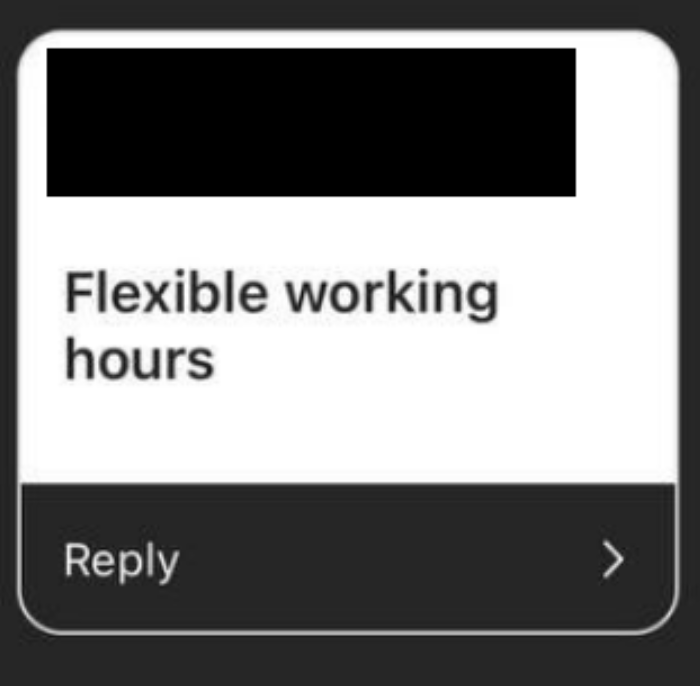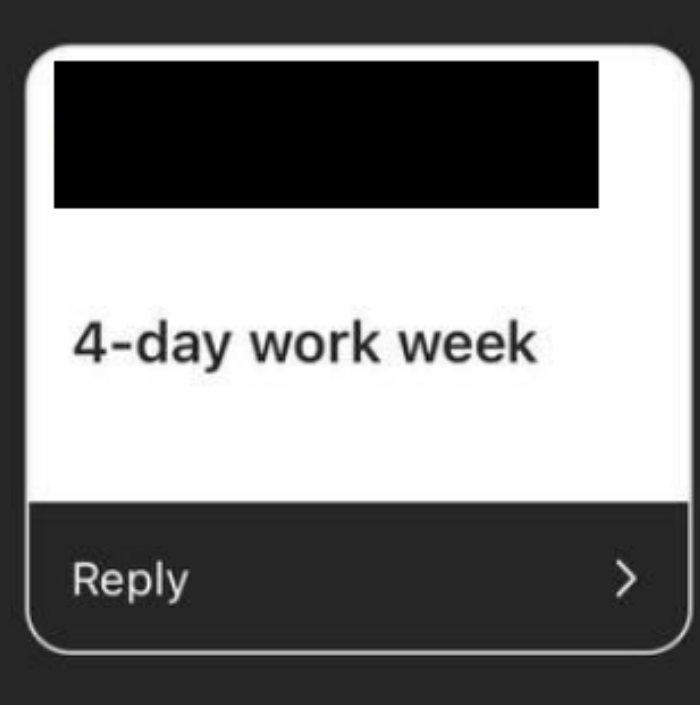Follow us on Telegram for the latest updates: https://t.me/mothershipsg
The latest buzz phrase in work right now is ✨work-life harmony✨. It’s all about maintaining that delicate but harmonious relationship between your career and your personal life.
But how does one go about doing it?
Earlier this year, we asked you on Instagram what would help with better work-life harmony, and the top suggestions revolve around two key themes:
- Clear separation of work and personal life
- Flexible work arrangements
All are wonderful suggestions but how do we achieve them? We sounded out a group of Work-Life Ambassadors to seek their advice.
Work-Life Ambassadors are business leaders, HR practitioners and working individuals who are knowledgeable and passionate about work-life harmony. They also possess a wealth of work-life expertise and experiences to share.
Separating work and life is all about respecting boundaries and mutual understanding
The most common suggestions we received from you relate to a separation between work and personal life: No work communications after working hours, on the weekends, and when one is on leave.



If you work a regular nine-to-five and generally find it easy not to take work home, then perhaps such an arrangement might work for you.
However, not every organisation can implement this. Some organisations, like those in the healthcare sector which operate 24/7 or small and medium enterprises (SMEs) which tend to have leaner manpower, might find it hard to adopt such a practice.
Even MNCs, which tend to have more manpower and well-established work processes, might find it difficult to implement a clear boundary between work and rest time since its staff need to work across different time zones.
Hard as it may be, it doesn’t mean that companies shouldn’t try at all. For a start, having a policy on after-hours communication will help set clearer expectations and boundaries .
The Alliance for Action on Work-Life Harmony has a pretty helpful sample that companies can use as a basis to develop their own after-hours communication policy.
However, the guiding principle behind a policy like this, said Senior Consultant Goh Wee Lee from Strategic Value Consulting Pte Ltd, is to respect boundaries and have mutual understanding between employers and employees.
 The guiding principle to separation of work and personal life is to respect boundaries and understand that there has to be some give and take between employer and employee. Photo by Cytonn Photography on Unsplash.
The guiding principle to separation of work and personal life is to respect boundaries and understand that there has to be some give and take between employer and employee. Photo by Cytonn Photography on Unsplash.
“For example, it is important for a company to explain that it respects boundaries and the needs of the staff. But on the other hand, when there are work exigencies, we also expect the staff to respond and help us. For example, there's a serious problem with shipment of goods, and we need the staff to work over the weekend.”
Nicholas Lim, a Work-Life Ambassador from Sony Singapore, shared that his department has an unspoken culture of not communicating work matters via a WhatsApp text after working hours.
And it is based on a very simple rationale: When you open WhatsApp, you don't do it in a stressful state, expecting work to inundate you.
“Messaging platforms like WhatsApp are used for us to happily maintain social ties with family and friends, not to induce stress via further work chats. Thus, work matters could be left to other mediums such as Microsoft Teams.”
At Sony Singapore, urgent work matters can be communicated via a phone call while non-urgent work messages can be transmitted through the company’s instant messaging system, and read on the next working day.
 Photo by Asterfolio on Unsplash.
Photo by Asterfolio on Unsplash.
Employees want flexible work arrangements and employers who listen will benefit too
The next top suggestions that we received relate to flexible work arrangements. Suggestions included having a telecommuting day each week, offering hybrid working arrangement, and having a four-day work week.



According to the Ministry of Manpower, there are multiple benefits for employers who implement flexible work arrangements. These include:
- Improved retention rates or lower resignation rates
- Increased ability to attract talent
- Lower absenteeism or sick leave
As a result of the pandemic, more employers are starting to recognise the benefits and feasibility of flexible work arrangements. Jacqueline Gwee, Director and Founder of aAdvantage Consulting Group Pte Ltd, observed that more firms are open to flexible working arrangements like a compressed work week (we say “compressed work week” because, as Gwee pointed out, you can work four days a week, but it doesn’t mean that you have fewer working hours).
This is especially true for companies with workers who work in 12-hour shifts — for instance, backend roles in the banking sector. They find it easier to transition to a compressed four-day work week.
Tang Mun Har, Director of Resource Consulting Pte Ltd, pointed out that a compressed work week arrangement might even be more feasible and effective for those who work on a project basis.
“A lot of companies with shift work extend working hours to 12 hours over a four-day work week. It may thus be more productive if they start that routine, and continue with it until that particular project is completed.”
In today’s context, more employees expect employers to offer some form of flexible work arrangement. And we’re not just talking about a compressed four-day work week. There are other forms of flexibility like part-time workand hybrid working arrangements, which entail a combination of telecommuting and onsite work.
 Flexible working arrangements like a compressed work week might not be for everyone in a company but it doesn’t mean that employers can’t implement it for those who are suited to it. Photo by Headway on Unsplash
Flexible working arrangements like a compressed work week might not be for everyone in a company but it doesn’t mean that employers can’t implement it for those who are suited to it. Photo by Headway on Unsplash
Tang explained:
“Basically, having that flexibility is no longer just a best practice, but something that a lot of organisations and employees increasingly come to expect. So, in that sense, we can’t reverse the flow and go back to what it used to be. It is inevitable and we have to move forward with this.”
And in a tight labour market with a manpower shortage, employers need to listen to their employees, said Gwee.
A particular form of flexible work arrangement can be effective for some but not all. Employees’ and business needs will vary at different life stages.
Hence, employers will need to tailor their practices and take into account their employees’ needs as well as the nature of their business operations.
For instance, employees with caregiving or health-related commitments but who are required to perform on-site shift work could be given the option of a compressed work week or flexible shift scheduling even if telecommuting is not feasible.
The key consideration for employers is this: Does the request of the employee fit with business requirements?
“If it does, then it’s a win-win for both (employer and employee). And if the employer wants to retain this person, then the answer would be, ‘yea, let’s make it work!’”
At the same time, employees need to consider the nature of their jobs and the feasibility of a desired form of flexible work arrangement within the business operations context when making a request. Regular and open communication between employer and employees is important to ensure flexible work arrangements are sustainable and win-win.
Support is available for companies to provide appropriate flexible working arrangements
Companies that found it challenging to implement flexible working arrangements shared some reasons why they could not do so:
- Nature of work required employees to be physically present
- Lack of knowledge on how to implement flexible working arrangements for employees
- Perception that flexible work arrangements do not add value to the company and staff would be less productive
On these concerns, the Ministry of Manpower said that companies can offer a wide range of alternative flexible work arrangements that can best meet employees’ needs while allowing them to perform effectively at work.
In addition, Tripartite Partners and members of the Alliance for Action on Work-Life Harmony have released practical resources for companies that may face unique implementation challenges.
Companies that require more support to implement flexible working arrangements can refer to TAFEP’s one-stop website for implementation resources or attend their courses and free clinics.
Setting work culture from the top
At the end of the day, it all boils down to two things, said Gwee.
The employer has to set clear policies and guidelines about working arrangements and working culture. These are then complemented by norms and behaviours that should be exemplified by senior management.
If being flexible and respecting boundaries are values that the company espouses, then they must be modelled by senior management for workers to see that these aren’t just words in a company handbook.
Tang concurred:
“Action speaks louder than words. Employees need to see their leaders actually practising what they're preaching. So it is important for the leaders to lead by example.”
Follow and listen to our podcast here
Working on this article which was sponsored by the Ministry of Manpower made this writer very thankful that his company allowed him to work from home once a week even before the pandemic.
Quotes were edited for clarity. Top photo adapted from Burst on Unsplash
If you like what you read, follow us on Facebook, Instagram, Twitter and Telegram to get the latest updates.
